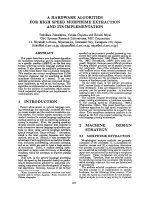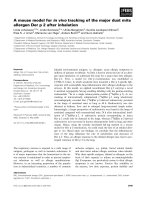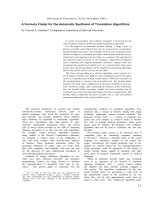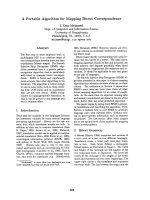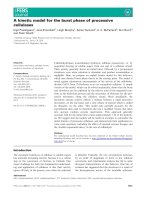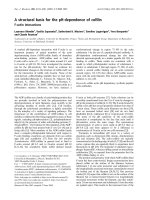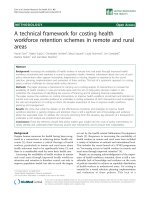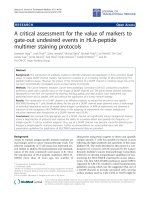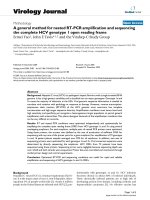Báo cáo sinh học: "A Monte-Carlo algorithm for maximum likelihood estimation of variance" pps
Bạn đang xem bản rút gọn của tài liệu. Xem và tải ngay bản đầy đủ của tài liệu tại đây (666.39 KB, 15 trang )
Original
article
A
Monte-Carlo
algorithm
for
maximum
likelihood
estimation
of
variance
components
S Xu
WR Atchley
2
!
Department
of
Botany
and
Plant
Sciences,
University
of
California,
Riverside,
CA
92521;
2
Department
of
Genetics,
North
Carolina
State
University,
Raleigh,
NC
27695,
USA
(Received
30
January
1995;
accepted
24
May
1996)
Summary -
A
new
algorithm
for
finding
maximum
likelihood
(ML)
solutions
to
variance
components
is
introduced.
This
algorithm
first
treats
random
effects
as
fixed,
then
expresses
the
pseudo-fixed
effects
as
linear
transformations
of
a
set
of
standard
normal
deviates
which
eventually
are
integrated
out
numerically
through
Monte-Carlo
simulation.
An
iterative
algorithm
is
employed
to
estimate
the
standard
deviation
(rather
than
the
variance)
of
the
random
effects.
This
method
is
conceptually
simple
and
easy
to
program
because
repeated
updating
and
inverting
the
variance-covariance
matrix
of
data
is
not
required.
It
is
potentially
useful
for
handling
large
data
sets
and
data
that
are
not
normally
distributed.
maximum
likelihood
/
restricted
maximum
likelihood
/
variance
component
/
Monte-
Carlo
/
mixed model
Résumé -
Un
algorithme
de
Monte-Carlo
pour
estimer
des
composantes
de
variance
par
le
maximum
de
vraisemblance.
Un
nouvel
algorithme
pour
résoudre
le
maximum
de
vraisemblance
de
composantes
de
variance
est
présenté.
Cet
algorithme
traite
d’abord
les
effets
aléatoires
comme
des
effets
fixes,
puis
exprime
ces
pseudo-effets
fixes
sous
la
forme
de
transformations
linéaires
d’un
ensemble
de
variables
normales
centrées
réduites.
Celles-ci
sont
ensuite
éliminées
par
intégration
à
l’aide
d’un
processus
numérique
de
Monte-Carlo.
Un
algorithme
itératif
est
employé
pour
estimer
l’écart
type
(et
non
la
variance)
des
effets
aléatoires.
Cette
méthode
est
simple
conceptuéllémént
et
facile
à
programmer
parce
que
des
inversions
de
la
matrice
de
variance-covariance
des
données
répétées
à
chaque
itération
ne
sont
plus
nécessaires.
La
méthode
peut
être
utile
pour
traiter
de
grands
ensembles
de
données
et
des
données
qui
ne
sont
pas
distribuées
normalement.
maximum
de
vraisemblance
/
maximum
de
vraisemblance
restreinte
/
composante
de
variance
/
Monte-Carlo
/
modèle
mixte
INTRODUCTION
Estimates
of
variances
and
covariances
have
been
used
extensively
in
animal
breed-
ing
(Henderson,
1986).
Recently,
much
attention
has
been
paid
to
natural
popula-
tions
(Guo
and
Thompson,
1991).
A
thorough
knowledge
of
genetic
variances
and
covariances
is
useful
in
determining
genetic
variability
of
a
population,
interpret-
ing
the
genetic
mechanism
of
quantitative
traits
and
estimating
heritabilities
and
genetic
correlation
of
quantitative
traits.
Those
genetic
parameters
are
necessary
in
planning
breeding
programs,
constructing
selection
indices,
estimating
breeding
values
of
candidate
breeders
and
predicting
selection
responses
(Henderson,
1986).
Various
methods
for
estimation
of
variance
components
have
been
developed.
A
general
review
can
be
found
in
Henderson
(1984)
and
Searle
(1989).
Among
these,
the
maximum
likelihood
(ML)
of
Hartley
and
Rao
(1967)
and
restricted
maximum
likelihood
(REML)
of
Patterson
and
Thompson
(1971)
are
the
most
popular
methods.
With
the
ML-related
methods,
large
computer
resources
and
CPU
times
are
required
due
to
repeatedly
inverting
the
variance-covariance
matrix
of
the
data.
The
derivative-free
algorithm
for
REML
(DF-REML)
has
been
suggested
by
Graser
et
al
(1987)
where
matrix
inversion
is
not
required,
rather,
Gaussian
elimination
is
used
(Smith
and
Graser,
1986).
With
the
advent
of
efficient
computer
programs
for
ML
and
REML
estimation
of
variance
components
such
as
the
DF
REML
program
of
Meyer
(1988),
large
data
set
(N
>
100 000)
can
be
handled
by
utilizing
the
sparse
matrix
technique
(see
Misztal,
1994;
Kriese
et
al,
1994
for
up-to-date
REML
programs).
Recently,
Guo
and
Thompson
(1991)
developed
a
Monte-Carlo
expectation-
maximization
(EM)
method
for
variance
component
estimation
which
uses
jointly
the
EM
algorithm
(Dempster
et
al,
1977)
and
the
Gibbs
sampler
(Geman
and
Geman,
1984).
Their
method
has
avoided
repeated
inversion
of
the
variance-
covariance
matrix.
An
alternative
algorithm
for
solving
ML
and
REML
solutions,
similar
to
Guo
and
Thompson
(1991),
is
reported
in
this
paper.
The
new
method
first
treats
random
effects
as
fixed
and
then
integrates
out
these
pseudo-fixed
effects
via
Monte-
Carlo
simulation.
In
the
case
where
data
are
normally
distributed,
there
is
an
explicit
form
of
the
multiple
integral,
but
the
explicit
form
involves
inverse
of
the
variance-covariance
matrix.
Instead
of
using
the
explicit
form
of
the
integral,
the
integration
is
carried
out
via
Monte-Carlo
simulation.
With
this
algorithm,
the
standard
deviation,
rather
than
the
variance,
of
the
random
effects
is
estimated
using
an
iterative
algorithm
similar
to
the
EM
algorithm
(Dempster
et
al,
1977).
This
method
does
not
require
updating
the
variance-covariance
matrix,
thus
may
need
less
computer
memory
than
other
methods.
As
a
result,
it
may
potentially
handle
large
dimensional
data
sets.
For
data
that
are
not
normally
distributed,
an
explicit
form
of
the
multiple
integral
is
not
available,
thus
the
Monte-Carlo
method
may
be
the
only
appropriate
way
to
solve
the
problem.
In
this
paper
application
of
the
Monte-Carlo
method
to
normal
data
for
ML
(or
REML)
estimation
is
reported.
The
result
serves
as
a
necessary
step
approaching
the
application
the the
new
method
to
non-normal
data.
THEORY
AND
METHODS
The
mixed model
We
will
use
the
simplest
mixed
model
with
one
class
of
random
effects
to
demon-
strate
the
new
algorithm.
The
model
is
shown
below:
where
y n
x
1
vector
of
observations
or
data,
b
p
x
1
vector
of
fixed
effects,
u
q
x
1
vector
of
random
effects
with
N(0, IQu),
e
n
x
1
vector
of
residuals
with
N(0, I
Q
e ),
X n
x
p
known
incidence
matrix
for
the
fixed
effects
with
a
rank
r,
Z n
x
q known
incidence
matrix
for
the
random
effects,
usually
with
full
column
rank.
It
is
assumed
that
E(yle)
=
Xb
and
Var(ylO)
=
V
=
ZZ
T
U2
-!
Iu
d,
where
e
=
[bo,
2
a2]
T
denotes
the
unknown
parameters
and
the
superscript
T
stands
for
matrix
transposition.
In
the
genral
framework
of
animal
breeding,
u
may
represent
sire
effects.
If
every
progeny
within
each
sire
has
a
different
dam
from
each
other,
the
variance
among
sires,
Q
u,
will
account
for
a
quarter
of
the
additive
genetic
variance
and
ae
will
contain
three-quarters
of
the
additive
genetic
variance
plus
the
variance
solely
due
to
environmental
effects
(deviation
of
phenotype
from
genotype).
The
likelihood
function
of
the
mixed
model
is
proportional
to
Note
that
this
likelihood
function
involves
inverting
the
variance-covariance
matrix
of
the
data
(V-
1
).
Conditional
on
the
random
effects
(u),
equation
[1]
is
a
fixed-effect
model
so
that
E(y!eu)
=
Xb
+
Zu
and
Var(y!eu)
=
lor,2,.
Furthermore,
u
can
be
obtained
by
linear
transformation
of
a
set
of
standard
normal
deviates,
ie,
u
=
so
u,
where
s -
N
QX
1
(0, I).
Thus,
conditional
on
s,
the
fixed
model
is
reformulated
as
With
such
a
fixed
model,
the
conditional
likelihood
function
is
proportional
to
Clearly,
matrix
inversion
is
not
involved
here.
However,
s
is
a
vector
of
random
variables
which
must
be
integrated
out
to
obtain
unconditional
estimates
of
e
=
[b,0
u
and
u,2].
Note
that
ufl
in
0
is
now
replaced
by
Q
&dquo;.
The
marginal
likelihood
function
This
likelihood
function
has
the
form
whose
explicit
form
[5]
is
equivalent
to
[2].
The
reason
to
reformulate
[2]
as
[5]
is
that
equation
[5]
can
be
approximated
by
Monte-Carlo
simulation,
as
suggested
by
Fahrmeir
and
Tutz
(1994).
Because
the
distribution
of
s
is
completely
known
(standard
normal),
we
can
generate
M
sets
of
random
normal
deviates
and
denote
the
ith
set
by
si.
Then
the
marginal
likelihood
function
can
be
approximated
by
where
f (y!0si)
is
given
in
[4]
with
s
substituted
by
si,
and
it
is
an
exponential
function
not
the
logarithm.
Hereafter,
M
is
called
the
length
of
the
Monte-
Carlo
simulation.
We
can
see
that
as
M -
oo,<y(y!8) —!
f(ylO).
Therefore,
maximum
likelihood
estimators
can
be
obtained
by
maximizing
g(y!0)
instead
of
f(ylo)
provided
that
M
is
large.
More
importantly,
when
<7(y!0)
is
used,
the
maximum
likelihood
solution of
the
parameters
can
be
easily
solved
via
an
iteratively
reweighted
least
squares
scheme.
The
iterative
algorithm
When
g(yIO)
is
used,
the
vector
of
parameters
becomes
0
=
[b T 0’ u 0’ e IIT
namely
<7u
is
estimated.
As
usual,
the
maximum
likelihood
solution
of
0
is
found
by
maximizing
L
=
log[g(yIO)]
instead
of
<?(y!0).
Let
us
first
define
the
following
partial
derivatives:
The
maximum
likelihood
estimators
(MLE
S)
are
obtained
by
setting
Dropping
the
constant
-1/2
Qe
in
the
above
equations
and
defining
we
have
the
following
ML
equations:
Unfortunately,
the
weight
pi
is
a
function
of
the
unknown
parameters,
therefore,
an
iterative
scheme
must
be
employed.
We
can
see
that
the
iterative
scheme
is
essentially
an
iteratively
reweighted
least
squares
approach.
The
iteration
takes
the
following
steps:
Step
1:
set
up
initials
for
b,
ou
and
Q
e;
Step
2:
evaluate
pi;
Step
3:
solve
for
b,
Q
&dquo;
and
Qe
using
[7]
and
[8];
Step
4:
update
b,
Q
&dquo;
and
ae
which
completes
one
cycle
of
iteration;
Step
5:
repeat
Steps
2-4
until
convergence.
The
MLE
of
u2
is
simply
the
square
of
the
MLE
of
au
due
to
the
invariance
prop-
erty
of
the
ML
method
(DeGroot,
1986).
The
iterative
algorithm
does
not
require
inversion
of
matrix
V;
rather,
it
only
requires
storing
the
following
quantities:
These
quantities
do
not
involve
the
unknown
parameters,
and
thus
do
not
need
to
be
updated;
rather,
they
can
be
calculated
after
the
random
normal
deviates
are
generated
and
before
the
iteration
is
invoked.
In
addition,
if
the
starting
value
of
uu
is
positive,
the
solution
to
uu
remains
positive
at
each
round
of
iteration.
If
O’u
starts
at
a
negative
value,
it
remains
negative
subsequently,
but
its
square
is
still
a
valid
ML
estimate
of
Q
u.
Note
that
pi
is
the
posterior
probability
density
whose
denominator
is
constant
across
i,
and
thus
can
be
dropped
without
altering
the
solutions.
For
computational
conveneince,
pi
is
redefined
as
pi
=
f(yl as
j)
hereafter.
Furthermore,
with
a
large
data
set,
pi
will
be
very
close
to
zero
and
may
cause
the
method
to
fail
due
to
numerical
problems.
This
can
be
circumvented
by
multiplying
pi
by
the
exponential
of
a
very
large
positive
number
whose
magnitude
is
comparable
to
A
candidate
of
such
a
number
may
be
where
or2 e
(O)
)
b(
o)
and
<
7u
(o)
are
chosen
such
that
they
are
close
to
the
true
parametric
values,
and
s(o)
is
an
arbitrary
Monte-Carlo
realization
of
vector
s.
The
modified
pi
has
the
following
form:
It
should
be
warned
that
the
value
of
c
stays
the
same
throughout
the
iterations
and
should
not
be
updated.
The
REML
The
Monte-Carlo
algorithm
also
works
for
the
REML
estimation
of
variance
components.
As
in
the
ML
analysis
described
earlier,
we
first
treat
the
random
effects
as
pseudo-fixed
effects,
then
express
the
model
by
a
linear
transformation
of
the
original
data,
ie,
where
s
is
a
q
x
1
vector
of
standard
random
normal
deviates
generated
via
Monte-
Carlo
simulation,
K
is
a
known
matrix
with
n
rows
and
n -
r
columns.
Matrix
K
is
chosen
such
that
KTX
=
0
(Patterson
and
Thompson,
1971).
One
such
a
choice
is
given
by
Harville
(1977)
as
any n -
r
independent
columns
of
matrix
I -
X(X
T
X)X
T.
After
the
linear
transformation,
the
model
does
not
depend
on
the
fixed
effects,
b.
Thus,
the
vector
of
unknown
parameters
becomes
0
=
[uuud]!.
Conditional
on
s,
the
expectation
and
variance
of
KT
y are
E(KT ylÐ s)
= K!Zso-u
and
Var(K
T
yIÐs)
=
KTK!e,
respectively,
Thus,
the
conditional
likelihood
func-
tion
is
proportional
to
The
marginal
likelihood
function
is
similarly
approximated
via
Monte-Carlo
simulation
and
has
the
following
form
where
f (KTy!9
Si
)
is
given
by
[11]
with
s
replaced
by
si.
Setting
partial
derivatives
of
L
=
log!g(KTy!9)!
with
respect
to
0
equal
to
zero,
we
have
where
is
again
the
posterior
probability
density.
Iteration
is
required
because
the
weight
pi
is
a
function
of
the
unknown
parameters.
Note
that
the
quantities
to
be
stored
are
{sTZTK(KTK)-lKTy!Mx1
and
f sTZTK(KTK)-lKTZsi!Mx1
which
do
not
involve
the
unknown
parameters,
hence
updating
is
not
necessary.
The
animal
model
Under
an
individual
animal
model,
the
genetic
value
of
each
animal
is
included.
It
has
the
form
where
u
is
an n
x
1
vector
of
additive
genetic
values
for
all
animals.
There
is
no
Z
matrix
here
and
u
are
correlated
through
the
additive
relationship
matrix
(matrix
A),
namely,
Var(u)
=
Aufl
and
ufl
is
the
additive
genetic
variance.
Let
Z
=
A1!2,
the
lower
Choleskey
decomposition
of
A.
Now
the
fixed
model
version
of
[15]
becomes
This
equation
is
exactly
the
same
as
[3]
except
that
Z
is
an
n
x n
lower
triangular
matrix
and
s
is
an n
x
1
vector
of
standard
normal
deviates
generated
via
Monte-
Carlo
simulation.
Therefore,
the
Monte-Carlo
algorithm
works
equally
well
with
an
animal
model.
Note
that
Var(Zso
u)
=
ZVar(s)Z
T
Qu
=
ZZ
TQu
=
A ufl
because
ZZ
T
=
A
and
Var(s)
=
I.
The
likelihood
function
for
an
animal
model
can
be
formulated
either
as
[6]
for
ML
estimation
or
as
[12]
for
REML
estimation.
With
an
animal
model,
the
typical
size
of
a
data
set
could
be
very
large,
making
factorization
of
A
into
Z
very
expensive.
In
addition,
matrix
A
is
dense
and
storing
it
may
not
be
feasible.
Here,
we
introduce
a
new
algorithm
that
can
avoid
these
difficulties.
Let
u
=
aau,
then
y
is
equation
[15]
can
be
remodeled
as
where
a
is
an
n
x
1
vector
with
N(0,
A)
distribution.
The
vector
a
can
be
simulated
as
follows:
for
founder j,
aj
is
sampled
from
an
N(0,1)
distribution;
for
non-founder
j,
aj
=
(a
m
+
af
)/2
+
’Yj
,
where
m
and
f
are
the
parents
of j
and -y
j
is
sampled
from
an
N(0,
1/2)
distribution.
We
have
now
avoided
the
use
of
matrix
factorization
by
directly
generating
vector
a
(instead
of
s)
and
subsequently
replacing
Zs
by
a.
AN
ILLUSTRATION
To
demonstrate
the
Monte-Carlo
algorithm,
data
originally
used
by
Cunningham
and
Henderson
(1968)
were
reanalyzed.
There
were
18
observations
classified
into
two
treatments
(fixed)
and
three
blocks
(random).
No
correlation
between
blocks
was
assumed.
The
data
was
described
by
model
[1].
The
estimates
of
(7;
and
or
2
were
given
by
Patterson
and
Thompson
(1971),
which
are
ML:
Qe
=
2.3518
and
a2
=
2.5051;
REML:
%d
=
2.5185
and a2
=
3.9585.
The
length
of
the
Monte-Carlo
algorithm
varied
from
10
to
31623,
which
have
a
log
io
scale
ranging
from
1.0
to
4.5
incremented
by
0.5.
The
experiment
was
replicated
20
times.
Results
of
the
ML
estimates
are
plotted
against
the
length
in
log
lo
scale
as
shown
in
figures
1
and
2.
When
log
io
(M)
=
3.5,
the
MLE
of
(7!
stabilized
at
the
true
maximum
likelihood
estimate
(fig
1),
while
the
estimate
of
or
took
only
log
lo
(M)
=
3.0
to
stabilize
(fig
2).
From
these
two
figures
we
also
observed
that
when
log
lo
(M)
<
3.0
the
Monte-Carlo
estimation
tends
to
be
biased
(downward).
The
standard
deviation
among
the
20
replicates
are
plotted
against
the
length
as
shown
in
figure
3.
Similar
results
were
also
observed
for
the
REML
estimates
(see
figs
4-6).
Downward
baseness
may
be
a
general
property
of
the
Monte-Carlo
method
for
small
M
because
biases
in
both
ML
and
REML
estimates
are
downward.
Further
investigation
is
necessary
to
quantify
the
expected
bias
for
small
M.
In
conclusion,
the
Monte-Carlo
algorithm
does
converge
to
the
true
ML
or
REML
estimates
for
both
(7!
and
u2
e.
Estimate
of (
7;
converges
more
quickly
than
that
of
(7!.
For
this
particular
data
set,
a
length
of
M =
1000-5 000
seemed
to
be
sufficient.
M !
5 000
may
also
serve
as
a
guideline
for
other
data
sets
(see
Discussion).
The
major
advantages
of
the
Monte-Carlo
algorithm
presented
in
this
paper
rely
on
its
conceptual
simplicity
and
easy
programming.
There
are
two
strategies
to
implement
the
Monte-Carlo
algorithm.
One
is
to
generate
the
random
numbers
before
invoking
the
iteration.
In
ML
analysis,
this
requires
storing
the
following
quantities:
{s;Z
T
ZS
í}
MX1
,
{S
;Z
TY}
MX1
and
{s!Z!X}Mxt-
The
number
of
stor-
age
units
required
is
jk + 2)
x
M.
In
REML
analysis,
the
quantities
to
be
stored
are
{s;Z
T
K(K
T
K)-
lK Y}
MX1
and
{s;ZTK(KTK)-lKTZsdMX1’
where
the
num-
ber
of
storage
units
is
2M.
Although
REML
needs
less
computer
memory
than
ML,
additional
CPU
time
is
required
for
evaluating
K(K
T
K)-
1KT.
Once
these
quan-
tities
are
generated,
however,
ML
takes
more
CPU
time
than
REML
for
iteration
because
ML
needs
repeated
evaluation
of
equation
[7]
which
is
not
trivial
for
a
large
number
of
fixed
effects.
The
second
strategy
is
to
generate
the
random
numbers
as
needed
using
a
reseed
with
the
same
number
strategy
in
the
pseudo-random
number
generator.
This
would
have
a
substantial
CPU
load
but
does
not
require
storing
those
quantities
needed
by
the
first
strategy.
In
either
case,
generating
the
quan-
tities
such
as
sTZ
T
K(K
T
K)-
lKT
Zs
i
must
resort
to
special
techniques
for
large
data
sets
(eg,
Perez-Enciso
et
al,
1994).
When
applied
to
large
data
sets,
the
Monte-Calro
algorithm
is
powerful
for
ML
analysis,
but
inefficient
for
REML
analysis
because
it
involves
matrix
K(K
T
K)-
1KT
which
looks
formidable.
The
K
matrix
may
be
avoided
by absortion
of
fixed
effects
using
Guassian
elimination,
but
it
is
still
expensive
for
more
than
fixed
effect.
Further
investigation
is
necessary
to
implement
this
algorithm
to
REML
analysis.
Using
the
first
strategy
of
Monte-Carlo
simulation,
matrix
factorization
and
inversion
(the
latter
is
required
in
REML)
are
done
only
once,
which
makes
the
first
strategy
more
desirable
than
the
second.
For
a
reasonable
number
of
levels
of
fixed
effects
(eg,
k
=
10),
the
number
of
storage
units
required
is
solely
determined
by
M.
For
example,
if
M
=
5 000,
the
number
of
storage
units
will
be
(10
+
2)
x
5 000
for
ML
and
2 x
5 000
for
REML.
Such
a
number
of
storage
units
may
be
easily
handled
by
standard
PCs.
The
question
becomes
whether
M
=
5 000
is
sufficient
or
not.
The
example
previously
described
shows
that
M
=
5 000
is
sufficient.
This
number
may
also
serve
as
a
general
guideline
because
it
does
not
depend
on
the
size
of
the
data
set.
Fahrmeir
and
Tutz
(1994)
state
that
the
computing
load
of
Monte-
Carlo
multiple
integration
increases
linearly
with
the
dimension
of
the
integral.
Here,
the
computing
load
is
not
M
but
M
x
q
(the
total
number
of
random
normal
deviates
generated),
where
q is
the
dimension
of
u.
We
can
see
that
M
x
q is
already
proportional
to
q.
Thus,
we
will
not
expect
M
to
increase
with
q.
We
have
demonstrated
the
Monte-Carlo
algorithm
under
the
situation
of
one
class
of
random
effects.
Extension
to
more
classes
of
random
effects
is
straight-
forward.
Suppose
that
the
mixed model
has
the
form
where
W
is
a
known
matrix
and
v
is
another
vector
of
random
effects
with
v N
N(O,lov2).
Here
we
assume
Cov(u, v
T)
=
0.
Conditional
on
two
independent
sets
of
random
normal
deviates,
s and
z,
the
fixed
model
equivalence
of
the
above
model
is
To
obtain
the
marginal
likelihood
function,
one
simply
generates
M
sets
of
si
and
zi
to
approximate
the
multiple
integral.
A
similar
algorithm
can
be
employed
to
simultaneously
estimate
b,
Q
&dquo;,
Q
,,
and
ae 2
The
Monte-Carlo
algorithm
presented
in
this
paper
should
be
considered
as
an
alternative
method
for
estimation
of
variance
components.
Similar
to
the
Monte-
Carlo
method
of Guo
and
Thompson
(1991),
the
method
proposed
here
is
ineffective
for
estimating
the
likelihood
under
mixed
inheritance.
In
addition,
large
pedigrees
(say
1000
members)
would
be
needed
to
demonstrate
its
effectiveness
under
polygenic
inheritance.
Furthermore,
with
a
normal
distribution,
the
new
method
perhaps
does
not
offer
too
much
advantage
over
the
existing
algorithms
that
use
the
sparse
matrix
technique.
Therefore,
by
no
means
should
the
Monte-Carlo
method
replace
those
conventional
algorithms.
For
data
that
are
not
normally
distributed,
however,
the
Monte-Carlo
algorithms
is
perhaps
the
only
convenient
way
to
solve
the
problem.
Many
economically
important
traits
of
animal
species
are
not
normally
distributed,
such
as
binary
disease
resistant
traits
or
ordinal
categorical
traits.
When
analyzing
such
traits,
one
usually
assumes
that there
is
a
continuous
latent
variable
(liability)
controlling
the
phenotype.
The
link
between
the
liability
and
the
discrete
phenotype
may
be
described
by
Wright’s
(1934)
physiological
threshold
model.
To
estimate
the
genetic
variance
of
the
liability
and
the
thresholds,
one
can
easily
establish
a
fixed
model
equivalence
of
the
likelihood
function
similar
to
equation
!4!.
The
random
effects
are
then
integrated
out
to
obtain
an
integrated
likelihood
function.
Certainly,
there
is
no
explicit
form
for
the
multiple
integral
and
Monte-Carlo
method
may
be
the
only
appropriate
way
for
such
a
large
dimensional
multiple
integration.
Results
from
this
research
(normal
data)
serve
as
a
necessary
first
step
approching
to
application
of
the
new
method
to
non-normal
data.
Finally,
it is
necessary
to
clarify
a
potential
confusion
between
this
method
and
the
Gibbs
samplers
of
Guo
and
Thompson
(1991)
and
Wang
et
al
(1993).
Each
method
involves
maximizing
integrated
likelihoods
and
the
integration
is
numerically
approximated
by
drawing
pseudo-random
deviates
from
presumably
known
conditional
distributions.
However,
the
Monte-Carlo
EM
method
of
Guo
and
Thompson
(1991)
generates
the
joint
posterior
distribution
of
the
random
effects
using
the
Gibbs
sampling.
This
method
generates
the
same
estimates
of
variance
components
as
the
usual
ML
method.
The
Gibbs
sampler
of
Wang
et
al
(1993)
generates
the
marginal
posterior
distribution
of
each
variance
component.
This
method
is
a
Bayesian
approach
in
that
it
requires
prior
distributions
of
the
unknown
parameters
and
then
integrates
out
all
other
parameters
except
the
one
of
interest.
Each
parameter
is
then
estimated
by
maximizing
its
own
marginal
likelihood
function.
The
Gibbs
sampler
of
Wang
et
al
(1993)
does
not
produce
new
estimators
but
the
Bayesian
estimates
of
the
variance
components.
The
Monte-
Carlo
algorithm
presented
in
this
paper
first
treats
the
random
effects
as
fixed
and
then
generates
the
marginal
distribution
of
the
data
via
Monte-Carlo
sampling.
Similar
to
the
derivative-free
algorithm
for
REML
(Graser
et
al,
1987),
our
method
is
only
an
alternative
algorithm
to
obtain
the
ML
and
REML
estimates.
It
does
not
generate
new
estimates
of
variance
components,
provided
M
is
sufficiently
large.
ACKNOWLEDGMENTS
We
thank
two
anonymous
reviewers
for
their
suggestions.
This
work
was
supported
by
NRI
Competitive
Grants
Programs/USDA
95-37205-2313
to
SX
and
the
National
Science
Foundation
BSR-9107108
and
the
National
Institutes
of
Health
GM
45344
to
WRA.
REFERENCES
Cunningham
EP,
Henderson
CR
(1968)
An
iterative
procedure
for
estimating
fixed
effects
and
variance
components
in
mixed
model
situations.
Biometrics
24,
13-25
DeGroot
MH
(1986)
Probability
and
Statistics.
Addison-Wesley,
MA,
USA
Dempster
AP,
Laird
NM,
Ribin
DB
(1977)
Maximum
likelihood
from
incomplete
data
via
the
EM
algorithm.
J
R
S’tat
Soc
B
39,
1-38
Fahrmeir
L,
Tutz
G
(1994)
Multivariate
Statistical
Modelling
Based
on
Generalized
Linear
Models.
Springer-Verlag,
New
York,
USA
Geman
S,
Geman
D
(1984)
Stochastic
relaxation,
Gibbs
distributions,
and
the
Bayesian
restoration
of
images.
IEEE
Trans.
Pattern
Anal
Machine
Intell 6,
721-741
Graser
HU,
Smith
SP,
Tier
B
(1987)
A
derivative-free
approach
for
estimating
variance
components
in
animal
models
by
restricted
maximum
likelihood.
J
Anim
Sci
64,
1362-
1370
Guo
SW,
Thompson
EA
(1991)
Monte-Carlo
estimation
of
variance
component
models
for
large
complex
pedigrees.
IMA
J
Math
Appl
Med
Biol
8,
171-189
Hartley
HO,
Rao
JNK
(1967)
Maximum-likelihood
estimation
for
the
mixed
analysis
of
variance
model.
Biometrika
54,
93-108
Harville
DA
(1977)
Maximum
likelihood
approaches
to
variance
component
estimation
and
to
related
problems.
J
Am
Stat
Assoc
72,
320-339
Henderson
CR
(1984)
ANOVA,
MIVC!UE,
REML,
and
ML
algorithms
for
estimation
of
variances
and
covariances.
In:
Statistics:
An
Appraisal:
Proceedings
50th
Anniversary
Conference
(David
HA,
David
HT,
eds),
The
Iowa
State
University
Press,
Ames,
IA,
257-280
Henderson
CR
(1986)
Recent
developments
in
variance
and
covariance
estimation.
J
Anim
Sci
63,
208-216
Kriese
LA,
Boldman
KG,
Van
Vleck
LD,
Kachman
SD
(1994)
MTDFREML:
A
flexible
set
of
programs
to
estimate
(co)variances
for
messy
multiple
trait
animal
models
using
derivative-free
REML
and
sparse
matrix
techniques.
In:
Proc
5th
World
Congress
on
Genetics
Applied
to
Livestock
Production,
7-12
August
1994,
University
of
Guelph,
Guelph,
ON,
Canada,
22,
43-46
Meyer
K
(1988)
DFREML -
a
set
of
programs
to
estimate
variance
components
under
an
individual
animal
model.
J
Dairy
Sci
71,
33-34
Misztal
I
(1994)
Comparison
of
software
packages
in
animal
breeding.
In:
Proc
the
5th
World
Congress
on
Genetics
Applied
to
Livestock
Production,
7-12
August
199l!,
University
of
Guelph, Guelph,
ON,
Canada,
22,
3-10
Patterson
HD,
Thompson
R
(1971)
Recovery
of
inter-block
information
when
block
sizes
are
unequal.
Biorrcetrika
58,
545-554
Perez-Enciso
M,
Misztal
I,
Elzo
MA
(1994)
FSPAK:
An
interface
for
public
domain
sparse
matrix
subroutines.
In:
Proc
5th
World
Congress
on
Genetics
Applied
to
Livestock
Production,
7-12
August
1994,
University
of
Guelph,
Guelph,
ON,
Canada,
22,
87-88
Searle
SR
(1989)
Variance
components -
some
history
and
a
summary
account
of
estimation
methods.
J
Anim
Breed
Genet
106,
1-29
Smith
SP,
Graser
HU
(1986)
Estimating
variance
components
in
a
class
of
mixed
models
by
restricted
maximum
likelihood.
J
Dairy
Sci
69,
1156-1165
Wang
CS,
Rutledge
JJ,
Gianola
D
(1993)
Marginal
inferences
about
variance
components
in
a
mixed
linear
model
using
Gibbs
sampling.
Genet
Sel
Evol
25,
41-62
Wright
S
(1934)
The
results
of
crosses
between
inbred
strains
of
guinea
pigs
differing
in
number
of
digits.
Genetics
19,
537-551
